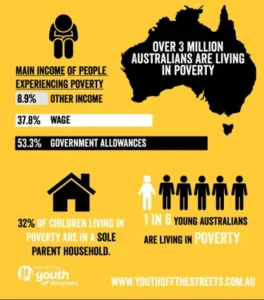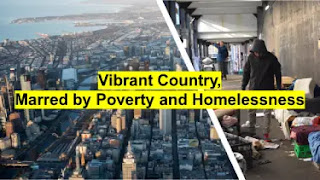Description
Explore addressing poverty in Australia using its sovereign currency and set a global standard for social justice.
Introduction: Unveiling the Paradox of Poverty in Prosperous Australia
Australia’s image as a land of wealth and opportunity is overshadowed by the harsh reality of poverty that affects millions of its citizens. Despite being one of the wealthiest nations globally, a sizeable part of the Australian population grapples with severe financial hardship every day. This article investigates the stark contrast between the country’s economic prosperity and the prevalent poverty, exploring how Australia’s financial autonomy and the capabilities of its sovereign currency can be pivotal in crafting effective solutions.
The Stark Statistics of Poverty in Australia
Understanding the Depth of Poverty

Recent studies show that over three million Australians live below the poverty line, defined as earning less than 50% of the median income. This statistic includes 739,000 children, highlighting a grave issue that extends across generations and affects the future of the nation.
Health Implications of Poverty
Living in poverty is not merely about limited financial resources but is intricately linked with worse health outcomes. Individuals and families facing poverty have higher rates of chronic diseases, including diabetes, heart disease, and mental health disorders. The direct correlation between financial hardship and poor health underscores the urgent need for comprehensive social and health policies.
Economic Burden of Poverty
The costs associated with poverty extend beyond the individual; they strain the entire healthcare system and have broader economic consequences. Estimates suggest that the health-related costs of poverty amount to billions of dollars annually in Australia, burdening the economy and worsening the cycle of poverty.
The Deepening Divide and Its Broader Impacts
Health and Well-being
The inadequate access to nutritious food, safe housing, and healthcare for families living in poverty not only diminishes individual health and life expectancy but also places a significant demand on public health services. These conditions create a healthcare system burdened by preventable diseases and conditions linked to poor living standards.
Educational Disparities
The link between poverty and education is profound. Children from low-income families are more likely to attend under-resourced schools, lack access to essential educational materials, and, so, face diminished future employment opportunities. This educational gap serves to perpetuate the cycle of poverty, as it hampers the ability of the next generation to achieve economic stability.
Income Inequality
The stark disparity in income distribution in Australia is highlighted by the fact that the wealthiest 20% of households control over 60% of all household wealth, while the poorest 20% hold less than 1%. This severe inequality not only affects the economic opportunities available to individuals but also affects their ability to take part fully in society.
Societal Costs
The broader societal effects of poverty include increased crime rates, lower productivity, and higher governmental welfare spending. These consequences underscore the necessity for targeted poverty reduction strategies that go beyond mere financial aid to address the structural causes of poverty and promote sustainable economic and social integration.
Understanding Australia’s Financial Autonomy and Sovereign Currency
Sovereign Currency and Economic Independence
Australia’s status as a sovereign currency nation provides it with unique financial capabilities. Unlike individual states or businesses, the government does not need to earn revenue before spending. This autonomy allows it to create and distribute resources in a manner that directly addresses the nation’s needs without being hindered by traditional budget constraints.
Potential of Sovereign Spending
The concept of sovereign spending is revolutionary in its promise to use the nation’s financial capabilities to eradicate poverty. By effectively harnessing these resources, the government has the potential to fund ambitious social programs that can provide meaningful support to those in need.
Inflation and Fiscal Responsibility
While the potential for inflation exists, it is only primarily a concern when the economy is at full capacity. If the government spends wisely in areas with available resources, it can stimulate growth without triggering inflation, thereby maximizing the benefits of its sovereign currency.
Conclusion: A Call to Action for a Fairer Australia
The challenge of poverty in Australia is daunting but not insurmountable. With strategic use of its financial autonomy and sovereign currency, Australia can implement robust social programs that significantly reduce poverty. This approach not only aids those directly affected but also helps the entire nation by improving public health, boosting educational outcomes, and strengthening the economy.
Q&A Section
Q: What does financial sovereignty mean for Australia?
A: It means Australia has the power to create and manage its own currency, giving it more control over its economic policies.
Q: How can financial sovereignty help reduce poverty?
A: By using its financial independence, Australia can fund programs and initiatives that directly target poverty, such as social welfare, education, and healthcare.
Questions for Readers
1. What are your thoughts on using Australia’s financial autonomy to combat poverty?
2. What barriers to implementing such policies do you foresee, and how might they be overcome?
Call to Action
Embrace the potential of Australia’s unique economic position to forge a path towards a poverty-free future. Share this article, engage in community discussions, and advocate for policies that use sovereign financial powers for social good. Together, we can make a difference in the lives of millions and set a global example of effective poverty alleviation.
By understanding Australia’s financial autonomy and the concept of sovereign currency, ordinary people can see that the government can address poverty and homelessness, if the focus is on effectively mobilizing available resources rather than worrying about finding the money.
References to support these claims:
– Mitchell, W., Wray, L. R., & Watts, M. (2019). “Macroeconomics.” Red Globe Press. Textbook: https://www.macmillanihe.com/page/detail/Macroeconomics/?K=9781137610669
– This textbook explains modern monetary theory and the role of sovereign currency.
– Tcherneva, P. R. (2020). “The Case for a Job Guarantee.”: https://www.politybooks.com/bookdetail/?isbn=9781509542090
– This book discusses how governments can use their financial sovereignty to address unemployment and social issues.
– Australian Government – The Treasury. (2020). “Economic Response to the Coronavirus.” Government Report: https://treasury.gov.au/coronavirus
– This report provides real-world evidence of how the Australian government used its financial sovereignty during the pandemic.
By understanding Australia’s financial autonomy and the concept of sovereign currency, ordinary people can see that the government can address poverty and homelessness, if the focus is on effectively mobilizing available resources rather than worrying about finding the money.

